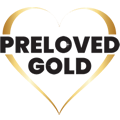What do you buy?
Preloved Gold buys most items containing precious metals such as gold, silver or platinum. We also buy jewellery, watches and precious metal ingots or nuggets. We also buy gold and silver coins.
We do not buy gold or silver plated items, or costume jewellery.
We do not buy individual diamonds or gemstones. If there are any precious stones included in your jewellery you may remove them prior to your item(s) being appraised. If you choose to leave the stones in, the weight of the stones will contribute to the total weight of each item and will be assessed as if the stone was made of the metal of the item.
- Jewellery: bracelets, chains, necklaces, earrings, rings, etc,
- Luxury Watches: Rolex, Omega, Breitling, TAG Heuer, Piaget, Bulgari, etc,
- Precious Metal Ingots, Bullion, Nuggets or scrap and broken pieces.
- Estate Jewellery , Antique Pocket Watches
How do we assess your items?
When we assess your items, we will examine and test them in a couple different ways.
1. XRF Analyser:Our appraisers use the ultramodern technology and our XRF machine (short for X-ray Fluorescent Analyser). This XRF Analyser is one of the most accurate analytical tools for the determining the chemical composition of your items. The emitted X-ray refract off the atoms inside items which, in turn feeds information back to the Analyser. Because the X-ray can identify and recognize the individual signatures of particular atoms according to their properties, we can then tell whether you are dealing with gold, silver or another type of metal. We offer complete gold and silver as well as precious metals analysis in real time using non-destructive gold testing equipment.
2. Hallmarks
Hallmarks are a mark struck on items made of precious metals mostly to identify and certify the contents, such as gold, platinum, silver and sometimes palladium. Its purpose is to identify the purity of the metal contained and most precious metal items such as jewellery and coins have this hallmark. Sometimes, it may be difficult to find it but here are some tips:
- Gold Coins - the stamp is in most cases on the front face.
- Rings and bands - the stamp is on the inside of the ring.
- Bracelets and Necklaces – the stamp is usually on the clasp.
- Look for the letter "K" as this designates the Carat or purity of the gold. Carat is measured up to 24K.
3. Acid test:
Gold is a noble metal which means it is resistant to corrosion, rust and acid. In order to test a certain metal, you rub a gold-colored item on black stone, and because gold is soft it will leave a mark on the stone. This test is also done for platinum and silver items. This small mark on the stone is then tested by applying acid, nitric acid which dissolves the gold, proving the item to be genuine. More accurate testing of the item for its purity can be done through the use of differing strengths of acid but the more pure the item is, the stronger the acid needed to dissolve it.
